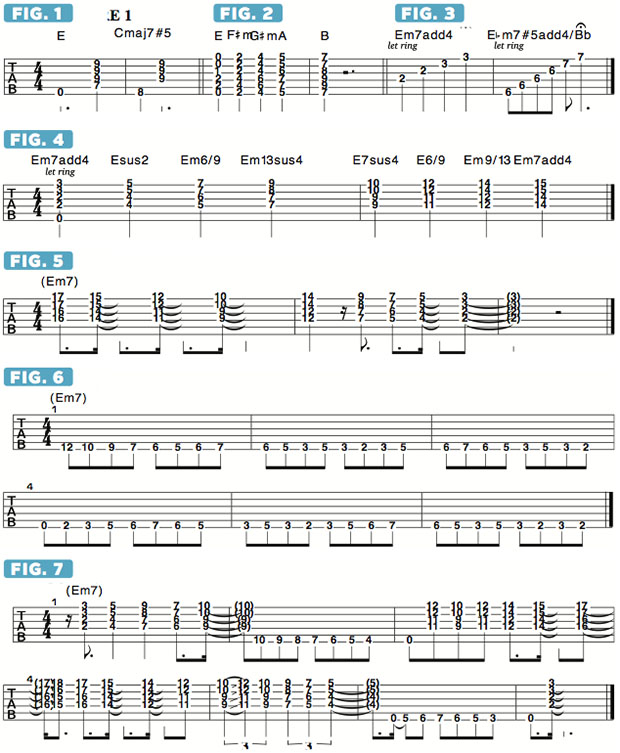Joe Satriani's Guide to Building Chords from “Stacked” Fourths
Satch demonstrates some interesting things you can do with stacked fourths.

If someone had mentioned the term “stacked fourths” to me years ago, I would have had no idea what they were talking about.
But I later learned that it is really quite simple and represents a cool approach to constructing chords. In this lesson, I’d like to show you some interesting things you can do with stacked fourths. In music theory, every note in a chord can be assigned an intervallic number. Typically, we’re dealing with scales built from five to eight notes, and each note is given a number to represent its placement within the given scale.
For example, the notes B, E and G# create the sound of an E major chord when played over an E bass note, as shown in bar 1 of FIGURE 1. Now, if I change the bass note to C, as in bar 2, a very different chord results: Cmaj7#5. Building chords that will stay within the specific key—remaining diatonic to it—is just a matter of picking the notes from that key’s scale or mode and only using them as chord tones.
This is the manner by which a harmonized scale can be built, as shown in FIGURE 2, wherein I use only notes from the E major scale (E F# G# A B C# D#) to form a series of chords that are constructed using stacks of thirds, fourths and fifths. One can alternatively build, or voice, chords from notes that are all four scale degrees apart from one another, what are known as fourths. Let’s look at an example. In FIGURE 3, the first chord is built from the notes E, A, D and G, yielding Em7add4. In this case, each note is a perfect fourth above the one below it, meaning two and one half steps, or semitones.
If I stack perfect fourths across all six strings, starting on the low E string’s sixth fret, the result is Ebm7#5add4/Bb. Sounds like something from the music of The Twilight Zone, right? A cool way to explore this stacked-fourths approach to voicing chords is to only use notes from a specific mode, such as E Dorian mode (E F# G A B C# D).
In FIGURE 4, I ascend through stacked-fourths voicings on the top four strings while sustaining the low E string as a pedal tone, for reference. Notice that, for the sake of staying within the confines of E Dorian, not all of the fourths are perfect, with a couple of them, namely G-C# and C#-G being what’s called an augmented fourth, also known as a tritone, which is equal to three whole steps.
Within the scope of rock music, you might need a wide artistic highway to incorporate these kinds of chords, but if the music you’re playing is experimental and open to jazz influences, stacked fourths are great to use when, for instance, you’re playing a rhythmic accompaniment over a static Em vamp for 16 bars. FIGURE 5 presents an improvised approach to using stacked-fourths voicings, which would sound good over a jazz-blues-style bass line, like the one in FIGURE 6. In FIGURE 7, I intertwine chords and bass line to further illustrate this approach. Once you get the hang of creating stacked-fourths voicings, try doing the same thing with other modes, such as Aeolian or Mixolydian.
All the latest guitar news, interviews, lessons, reviews, deals and more, direct to your inbox!

